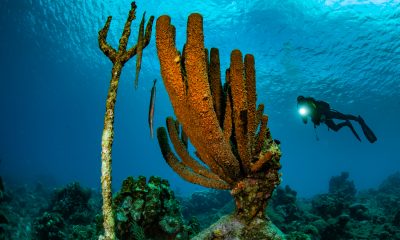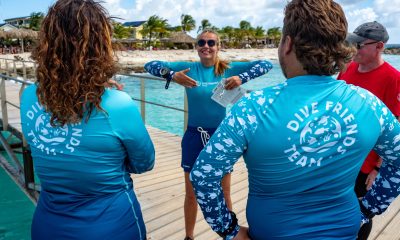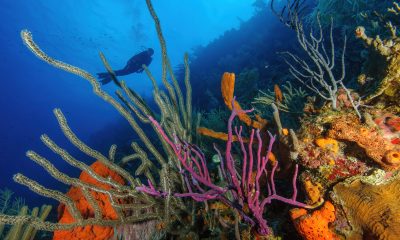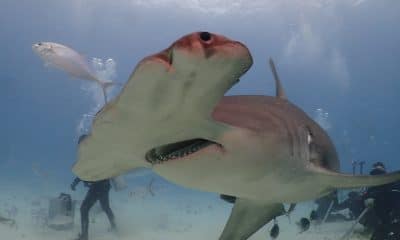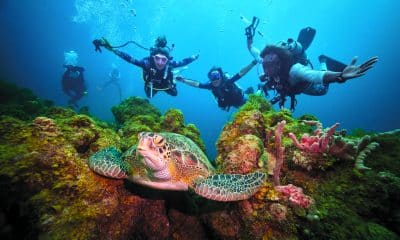News
Cayman’s Great Shore Diving Can Add Value to Dive Packages
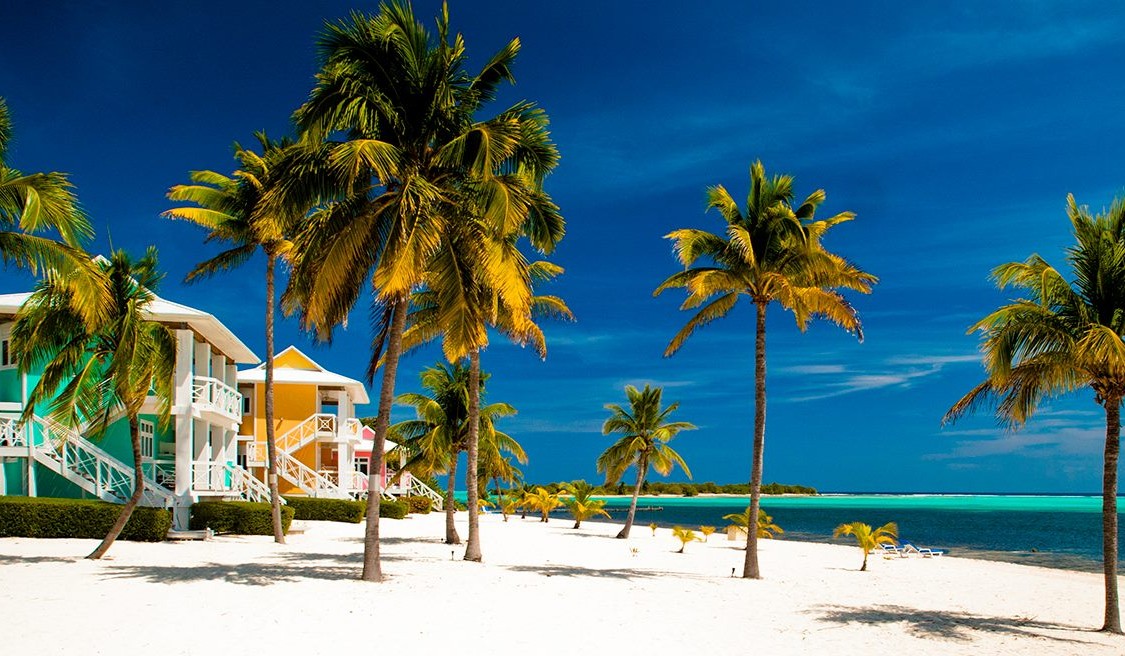
As one of the Caribbean’s top dive destinations, Cayman is renowned for fantastic wall dives, spectacular shipwrecks and unforgettable Stingray City, but avid divers know that Cayman’s shore diving sets it apart. Here they can maximize their bottom time and add value to dive package with easy shore diving. There are 365 dive sites on the three islands – reefs and shipwrecks in warm clear water, filled with all kinds of marine life. About 50 sites are accessible from shore, and 10 are organized shore diving locations with tank rentals, ladders, showers and other facilities. The rest are more suited for adventurous divers who are up for a shore entry off the beaten path without the amenities.
A newly-certified diver can do no better than Grand Cayman for a first ocean dive. Conditions are reliably good, and they can choose shallow reefs with grottos and swim-throughs or shipwrecks and underwater sculptures that offer their own attractions. Here are some of the most popular starting on the coast south of George Town and traveling north.
Sunset Reef
Sunset House Dive Resort is widely recognized for its easy shore diving. Visitors can literally walk from their room to pick up their dive equipment at the dive shop and then step into the water. Besides having 6 custom boats to take guests on boat dives, 100% of the Sunset House experience is its fantastic shore diving.
“We have multiple entry points, you can giant stride from the Iron shore or use the ladder in the ocean fed sea pool where divers can out the sea critters before exiting onto the dive site,” said Emma Jane Fisher, Sales and Marketing for Sunset House.
Fisher says divers can follow the natural navigation of the sand chutes to Sunset House’s 9 foot bronze mermaid sculpture, Amphitrite, which sits offshore from the resort in 50 feet of water. From there they can follow the large coral head to the sand flat where the wreck of the Nicholson, a World War II-era landing craft.
“The Nicholson is a great wreck to explore for macro life, beautiful soft corals & you might catch Eagle Rays passing by over the sand. They can then follow the coral ridge out until it rises to 55 feet before dropping into the abyss. As they follow the top of the wall and look out in to the blue, they never know what might swim by.”
Eden Rock and Devil’s Grotto are sites with coral caves and tunnels for divers to explore in downtown George Town. They have easy entry ladders, and during the summer months, divers can experience an extraordinary happening – Cayman’s thrilling “Silver Rush.” The near shore reefs are filled with millions of migrating silversides that swirl through the tunnels like quicksilver, and then large Tarpon show up to feast on the summer migrants.
Bob Soto’s Reef is located North of George Town Harbour just off Soto’s Pier at the Lobster Pot Restaurant. Accessible by ladder, divers can swim out directly from the pier to find a shallow reef with sandy bottoms where depth ranges between 20 – 50 feet. The reef includes caverns, caves and winding tunnels, and curious tarpon are often spotted.
The Wreck of the Cali, a four-masted schooner that sunk just outside the harbor during a storm in 1944, is scattered on the sandy ocean floor 24 feet, some areas in water as shallow as 10 feet. The site has great marine life, including large tarpon, and it’s an excellent dive for newbie divers. The Cali is also a great night dive.
Lighthouse Point and the Divetech Pier are located at Northwest Point of Grand Cayman in the West Bay Region. Divers can easily access the reef here from Divetech’s concrete pier and ladder, and from a saltwater pool that offers access to the sea. Directly out from the Divetech pier is a mini wall begins at 40 feet and drops to 60 feet, leveling off to a sandy flat. The mini wall runs parallel to the shoreline and is filled with sponges, corals and marine life. Divers can also visit The Guardian of the Reef, a bronze statue half man, half seahorse, that sits on a sandy flat just off the pier. Divetech specialize in Nitrox, rebreather and mixed gas training for advanced divers who want to maximize their bottom time. The dive shop also rents underwater scooters for divers who want to try a new adventure.
Turtle Reef, located next door to the Divetech pier, is also a popular shore dive accessible from shore. Nutrients from the nearby Turtle Farm attract feeding marine life, and the reef is accessible by step ladder or by entering in a cove right next to the Turtle Farm. Like Lighthouse Point, the depth at Turtle Farm Reef ranges from 40 – 60 feet.
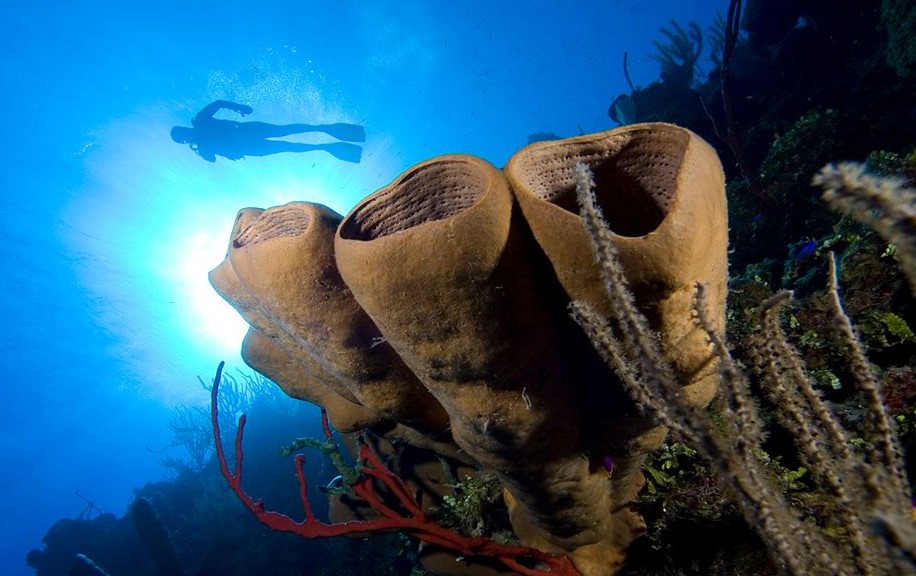
East End
The East End is typically renowned for boat diving, but there are a few sites that can be dived from shore. These sites are typically for the more advanced “adventure” divers because there are no ladders, marked access or entry points to the sites. East End shore diving typically involves walking over iron shore and then a considerable swim out. Access is determined by wind direction, so divers are asked to check with an East End dive operator for directions and tips on shore diving in this area.
Little Cayman
Although Little Cayman’s spectacular drop-offs at Bloody Bay Wall and Jackson Hole are best accessed by boat, there are a few sites available from shore. The Southern Cross Club offers tanks for in-house guests and resort dive staff can point out these unmarked sites, which are also excellent for snorkeling.
“Shore diving in Cayman is a great compliment to boat diving and adds a few extra dives to your log book that are at a different pace,” says Ocean Frontiers co-owner Steve Broadbelt. “Diving from shore lets you follow your own plan and go on an adventure as a buddy team, giving you freedom to explore or simply stay in one spot for the whole dive.”
Dive operators work hard to keep Cayman’s dive product healthy and top-notch. The latest project is centered on coral nurseries used to replenish local reefs. Ocean Frontiers, Sunset House and Divetech have all established nurseries and guests can participate in the coral restoration work. Former combat divers recently installed a bronze plaque at the base of the mermaid at Sunset House to commemorates the first mission for Force Blue, a non-profit organization training former combat divers about coral conservation.
All three operations offer tanks for shore diving as part of their vacation dive packages so visitors can make the most of their trip to the Cayman Islands.
Blogs
Northern Red Sea Reefs and Wrecks Trip Report, Part 3: The Mighty Thistlegorm
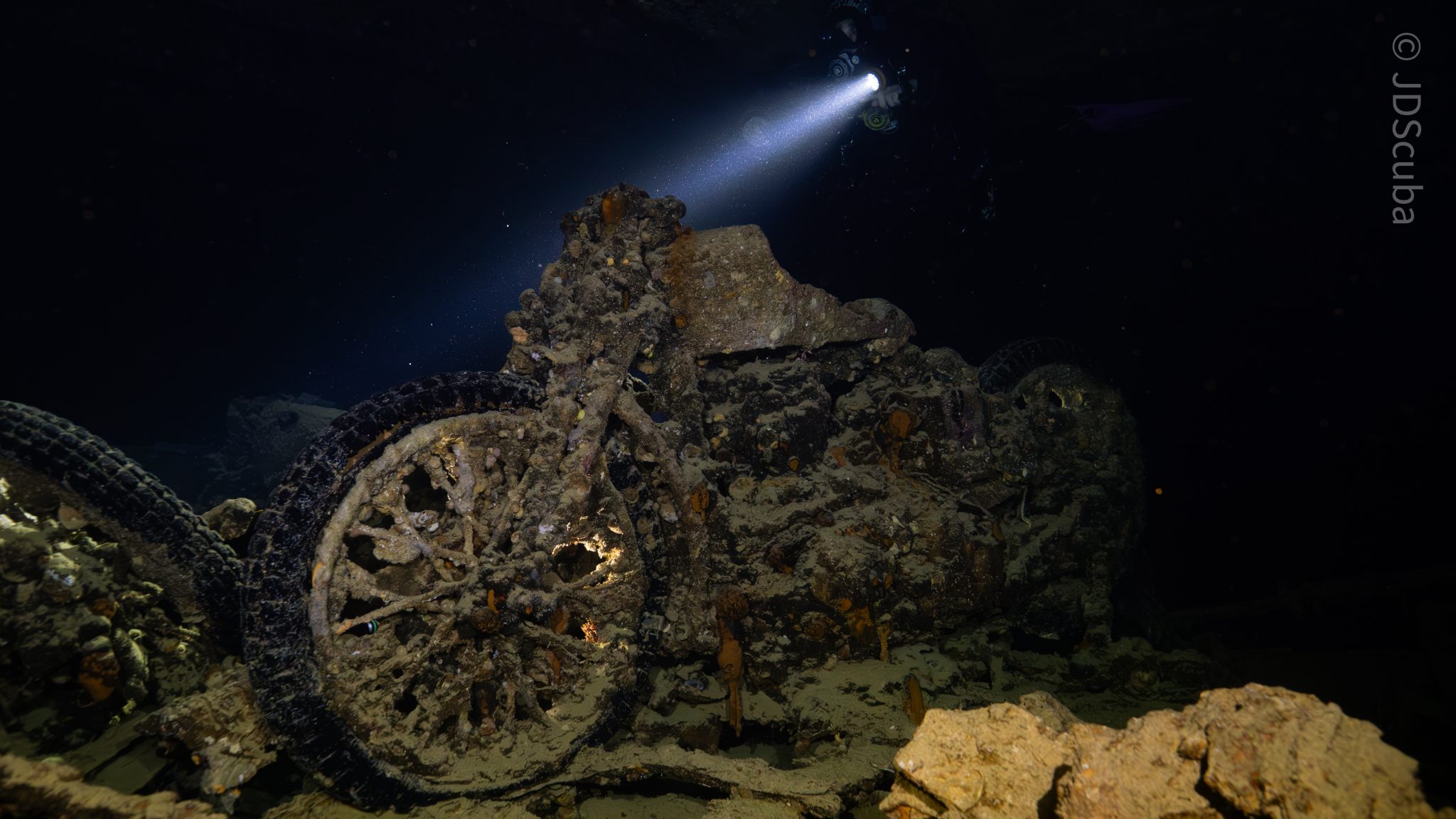
Jake Davies boards Ghazala Explorer for an unforgettable Red Sea diving experience…
Overnight, the wind picked up, making the planned morning dive a bit bumpy on the Zodiacs to the drop point on Thomas Reef. There, we would dive along the reef before descending through the canyon and then passing under the arch before ascending the wall with a gentle drift. The site provided great encounters with more pelagic species, including shoals of large barracuda, tuna, and bigeye trevally.
Once back on the boat, it was time to get everything tied down again as we would head back south. This time, with the wind behind us, heading to Ras Mohammed to dive Jackfish Alley for another great gentle drift wall dive before then heading up the coast towards the Gulf of Suez to moor up at the wreck of the Thistlegorm. This being the highlight wreck dive of the trip and for many onboard, including myself, it was the first time diving this iconic wreck. I had heard so much about the wreck from friends, and globally, this is a must on any diver’s list. Fortunately for us, there was only one other boat at the site, which was a rarity. A great briefing was delivered by Ahmed, who provided a detailed background about the wreck’s history along with all the required safety information as the currents and visibility at the site can be variable.
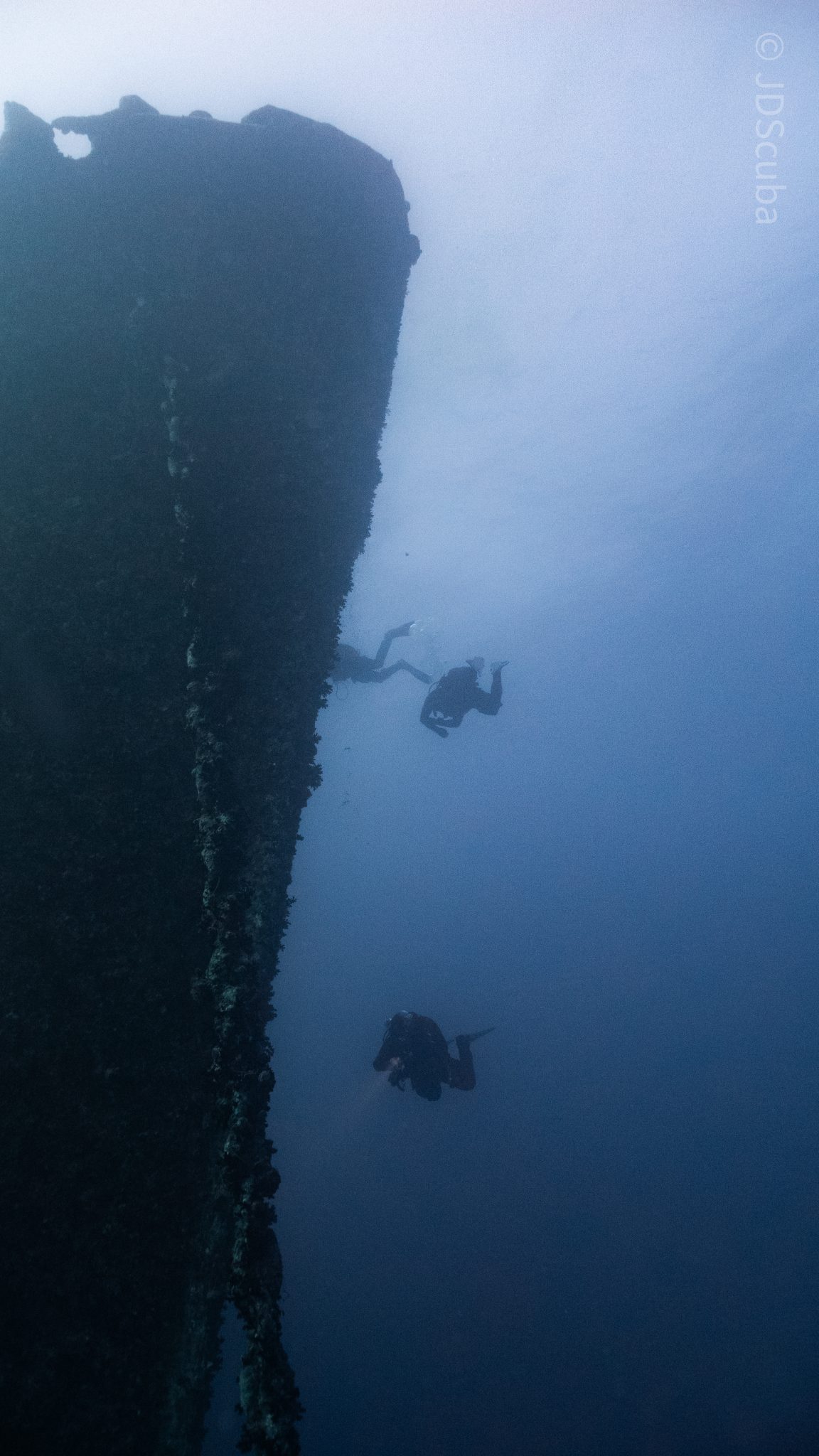
Kitting up, there was a lot of excitement on deck before entering the water and heading down the shoreline. Descending to the wreck, there was a light northerly current which reduced the visibility, making it feel more like the conditions that can be found off the Welsh coast. At 10m from the bottom, the outline of the wreck appeared as we reached the area of the wreck which had been bombed, as our mooring line was attached to part of the propeller shaft. Arriving on deck, instantly everywhere you looked there were many of the supplies which the ship was carrying, including Bren Carrier tanks and projectiles that instantly stood out.
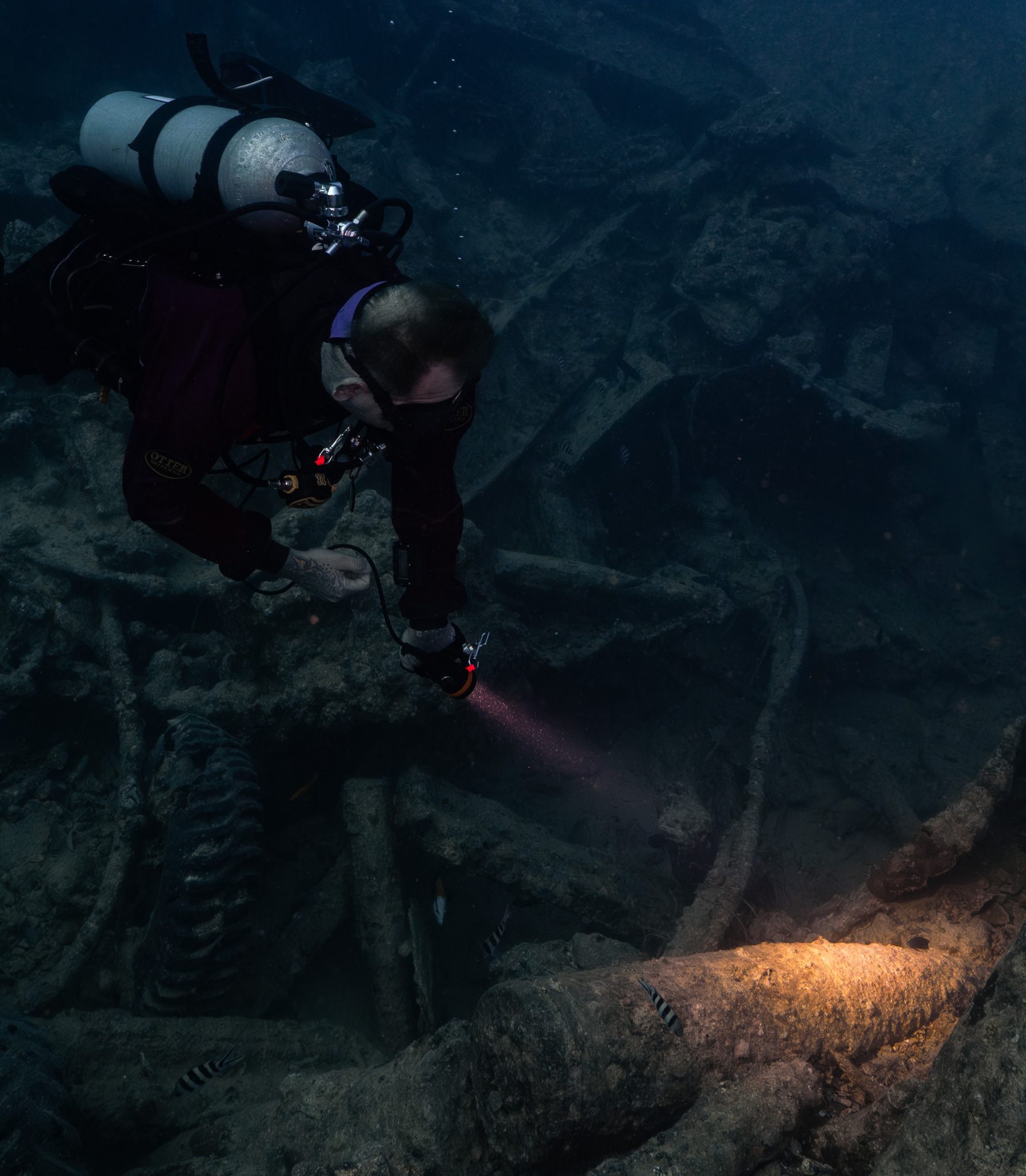
We headed around the exterior, taking a look at the large propeller and guns mounted on deck before entering the wreck on the port side to take a look in the holds. It was incredible to see all the trucks, Norton 16H, and BSA motorcycles still perfectly stacked within, providing a real snapshot in time.
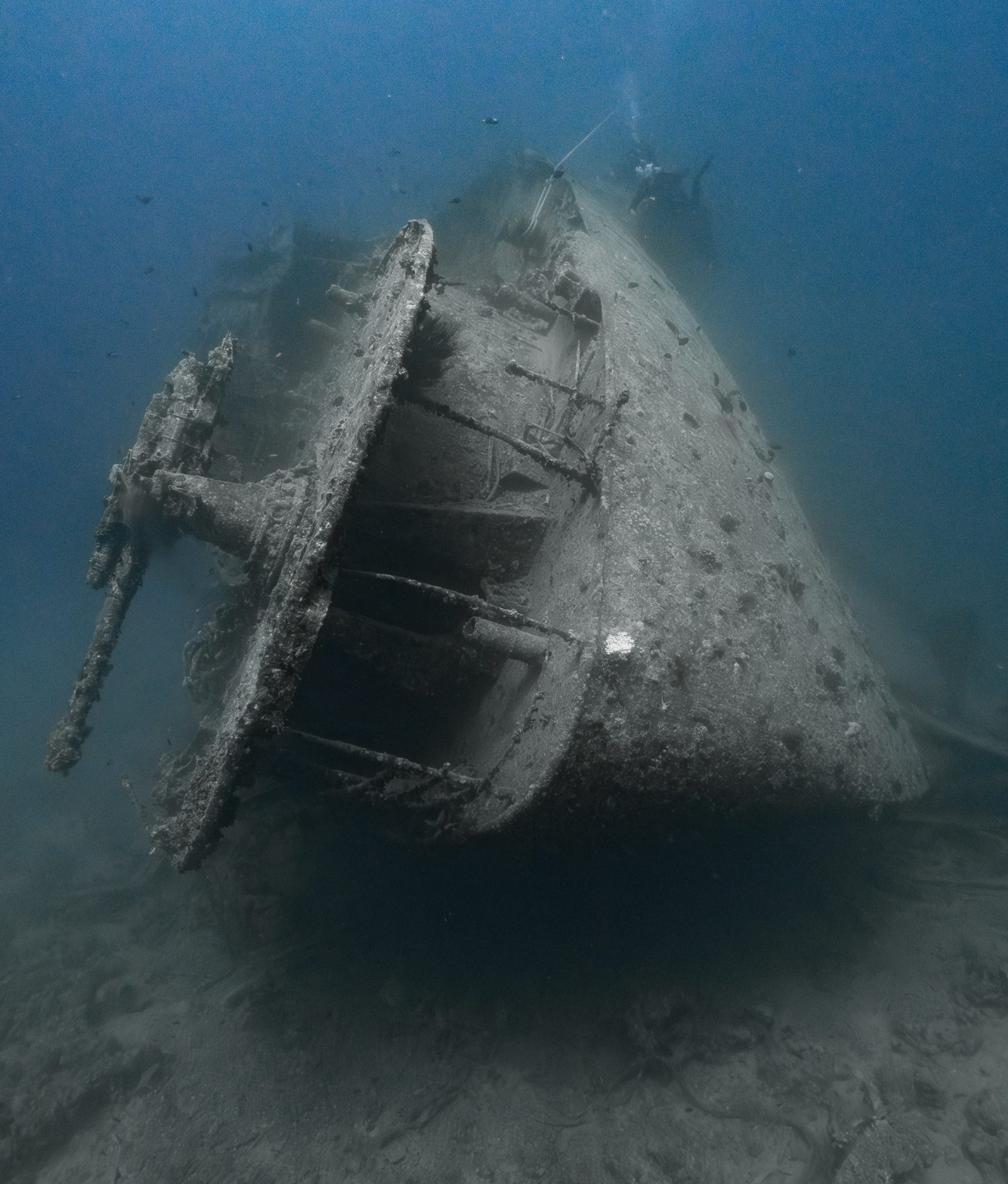
Overall, we had four dives on the Thistlegorm, where for all of the dives we were the only group in the water, and at times, there were just three of us on the whole wreck, which made it even more special, especially knowing that most days the wreck has hundreds of divers. Along with the history of the wreck, there was plenty of marine life on the wreck and around, from big green turtles to batfish, along with shoals of mackerel being hunted by trevally. Some unforgettable dives.

The final leg of the trip saw us cross back over the Suez Canal to the Gobal Islands where we planned to stay the night and do three dives at the Dolphin House for the potential of sharing the dive with dolphins. The site, which included a channel that was teeming with reef fish, especially large numbers of goatfish that swam in large shoals along the edge of the reef. These were nice relaxing dives to end the week. Unfortunately, the dolphins didn’t show up, which was okay as like all marine life they are difficult to predict and you can’t guarantee what’s going to be seen. With the last dive complete, we headed back to port for the final night where it was time to clean all the kit and pack before the departure flight the next day.
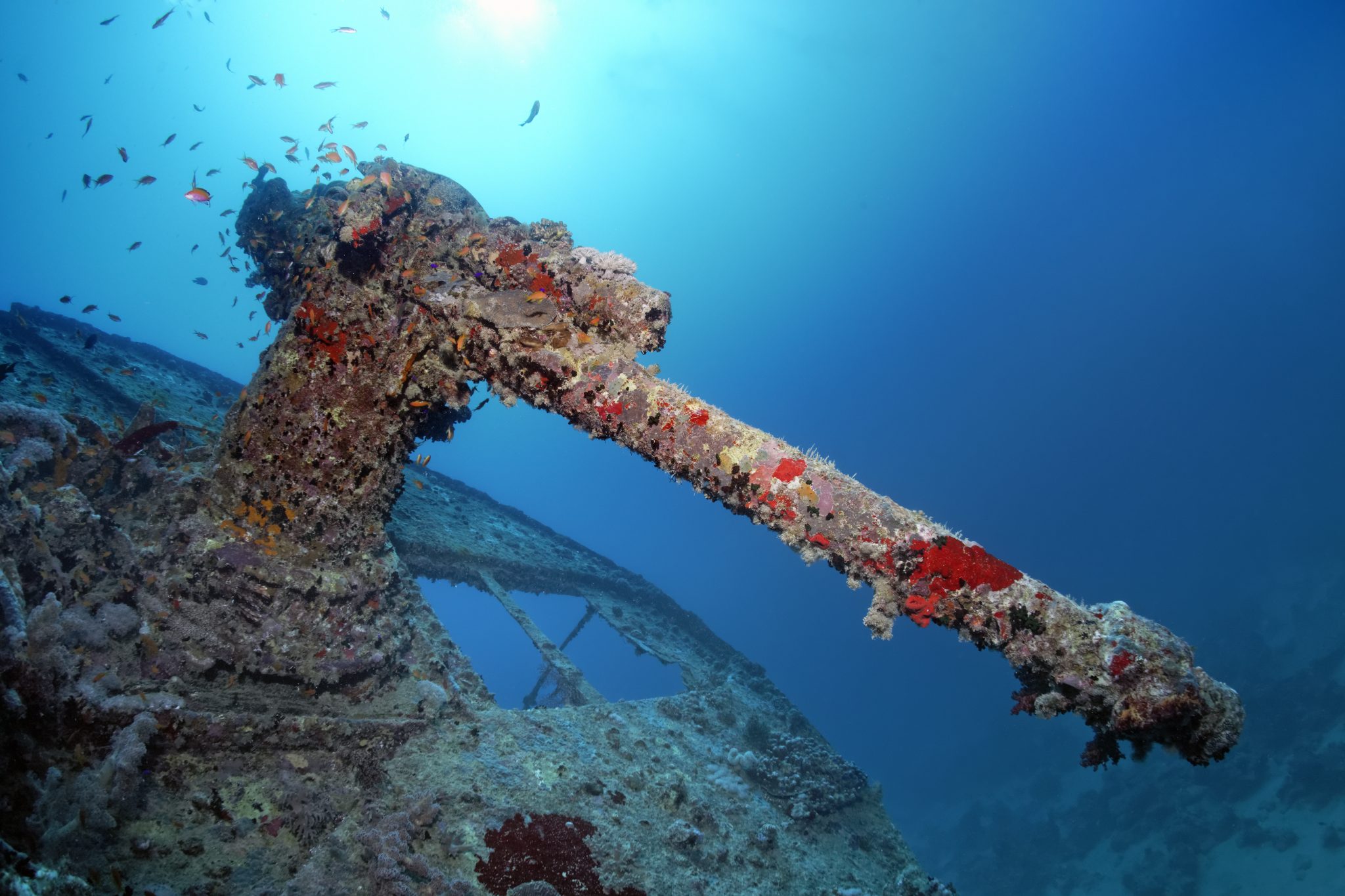
The whole week from start to finish on Ghazala Explorer was amazing; the boat had all the facilities you need for a comfortable week aboard. The crew were always there to help throughout the day and the chefs providing top quality food which was required after every dive. The itinerary providing some of the best diving with a nice mixture of wreck and reef dives. I would recommend the trip to anyone, whether it’s your first Red Sea liveaboard in the Red Sea or you’re revisiting. Hopefully, it’s not too long before I head back to explore more of the Red Sea onboard Ghazala Explorer.
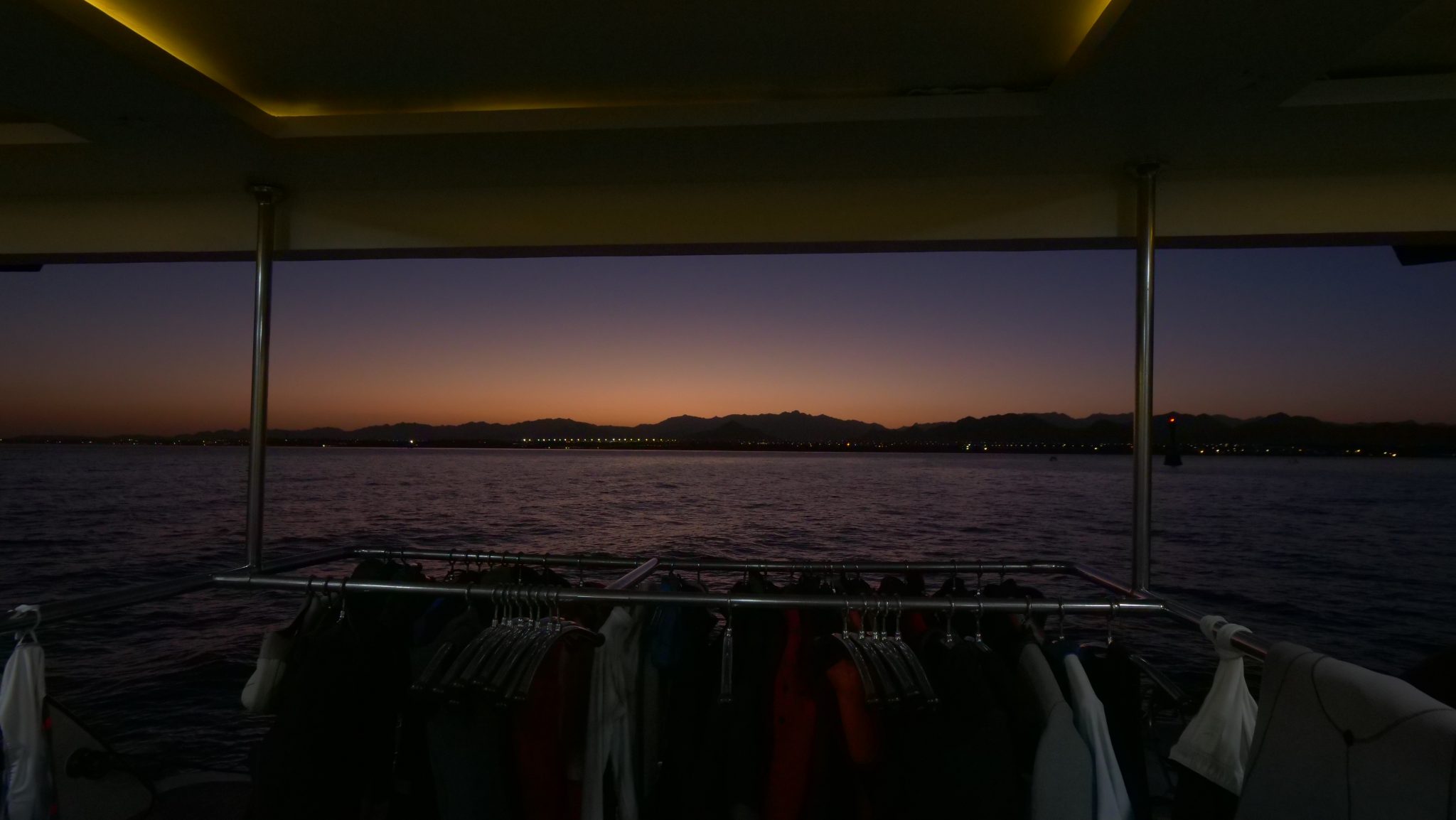
To find out more about the Northern Red Sea reef and wrecks itineraries aboard Ghazala Explorer, or to book, contact Scuba Travel now:
Email: dive@scubatravel.com
Tel: +44 (0)1483 411590
Photos: Jake Davies / Avalon.Red
Blogs
Northern Red Sea Reefs and Wrecks Trip Report, Part 2: Wall to Wall Wrecks
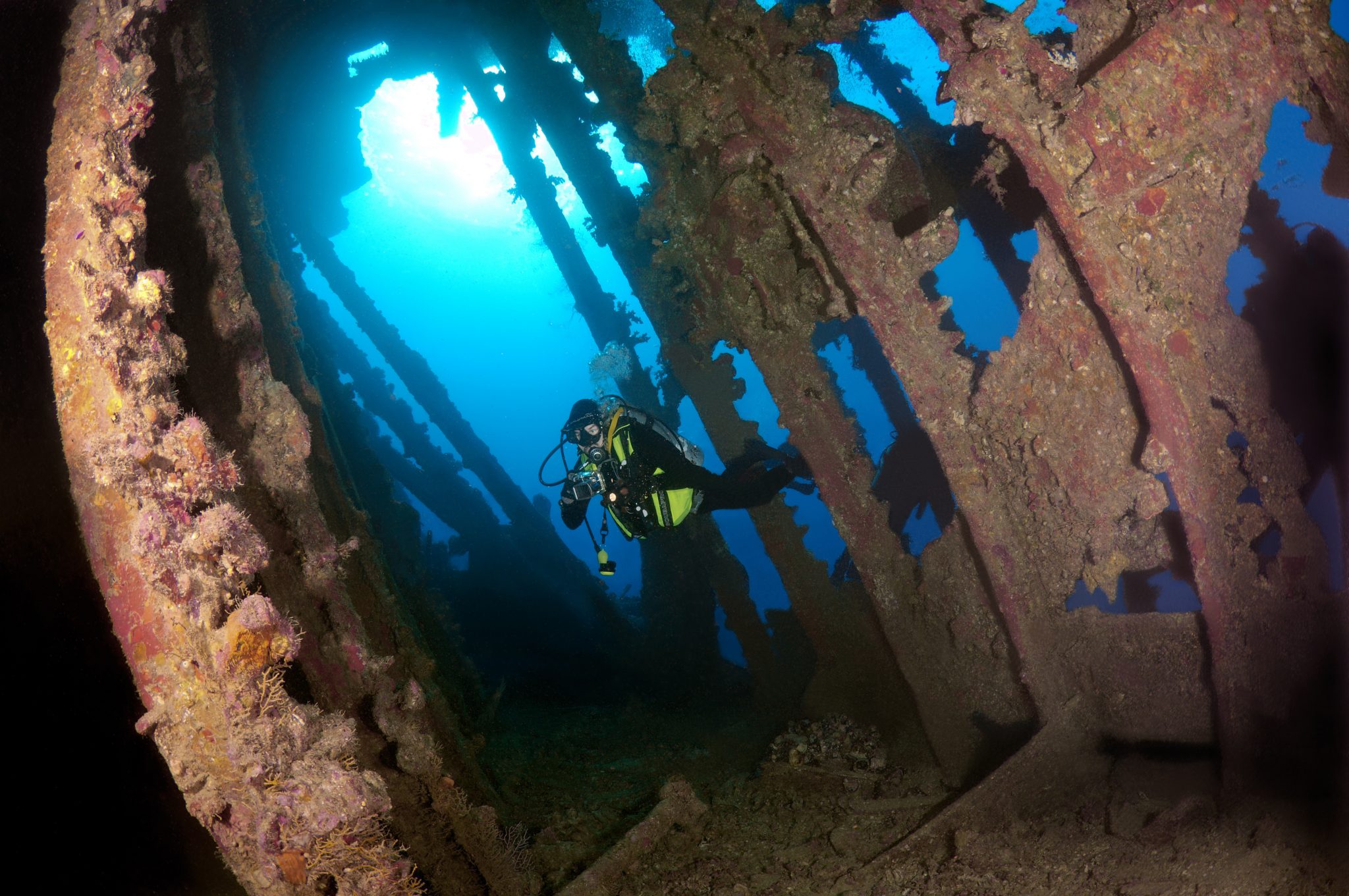
Jake Davies boards Ghazala Explorer for an unforgettable Red Sea diving experience…
The second day’s diving was a day full of wreck diving at Abu Nuhas, which included the Chrisoula K, Carnatic, and Ghiannis D. The first dive of the day was onto the Chrisoula K, also known as the wreck of tiles. The 98m vessel remains largely intact where she was loaded with tiles which can be seen throughout the hold. The stern sits at 26m and the bow just below the surface. One of the highlights of the wreck is heading inside and seeing the workroom where the machinery used for cutting the tiles are perfectly intact. The bow provided some relaxing scenery as the bright sunlight highlighted the colours of the soft coral reef and the many reef fish.
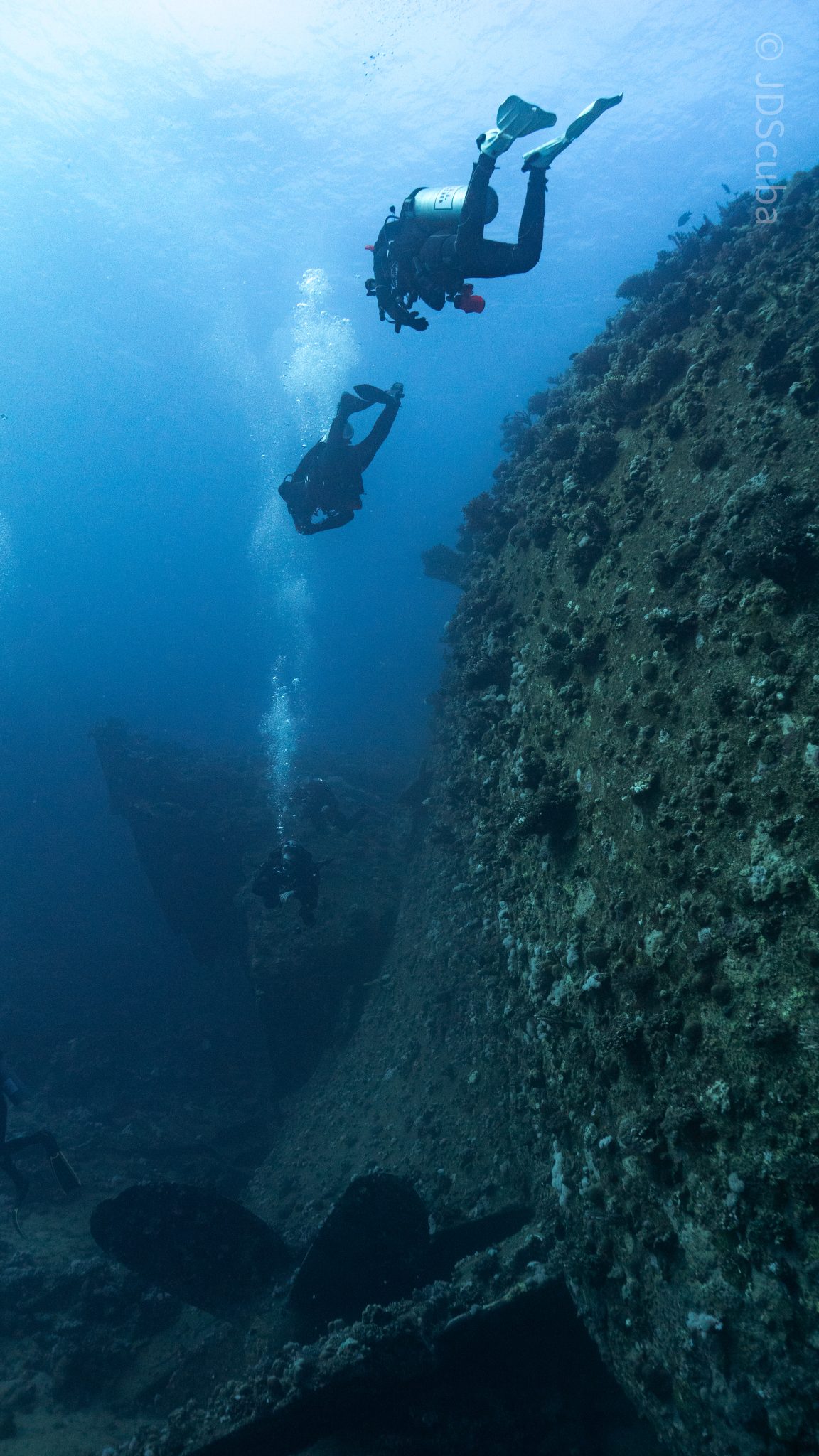
Following breakfast, we then headed to the next wreck, which was the Carnatic. The Carnatic is an 89.9m sail steamer vessel that was built in Britain back in 1862. She ran aground on the reef back in 1869 and remains at 27m. At the time, she was carrying a range of items, including 40,000 sterling in gold. An impressive wreck where much of the superstructure remains, and the two large masts lay on the seafloor. The wooden ribs of the hull provide structures for lots of soft corals, and into the stern section, the light beams through, bouncing off the large shoals of glass fish that can be found using the structure as shelter from the larger predators that are found outside of the wreck.

The final wreck at Abu Nuhas was the Ghiannis D, originally called ‘Shoyo Maru,’ which was 99.5m long and built in Japan back in 1969 before becoming a Greek-registered cargo ship in 1980. The ship then ran aground on the reef on April 19th, 1983, and now sits at the bottom at a depth of 27m. Heading down the line, the stern of the ship remains in good condition compared to the rest of the hull. The highlight of the wreck, though, is heading into the stern section and down the flights of stairs to enter the engine room, which remains in good condition and is definitely worth exploring. After exploring the interior section of the ship, we then headed over to see the rest of the superstructure, where it’s particularly interesting to see the large table corals that have grown at the bow relatively quickly considering the date the ship sank. After surfacing and enjoying some afternoon snacks, we made sure everything was strapped down and secured as we would be heading north and crossing the Gulf of Suez, where the winds were still creating plenty of chop.
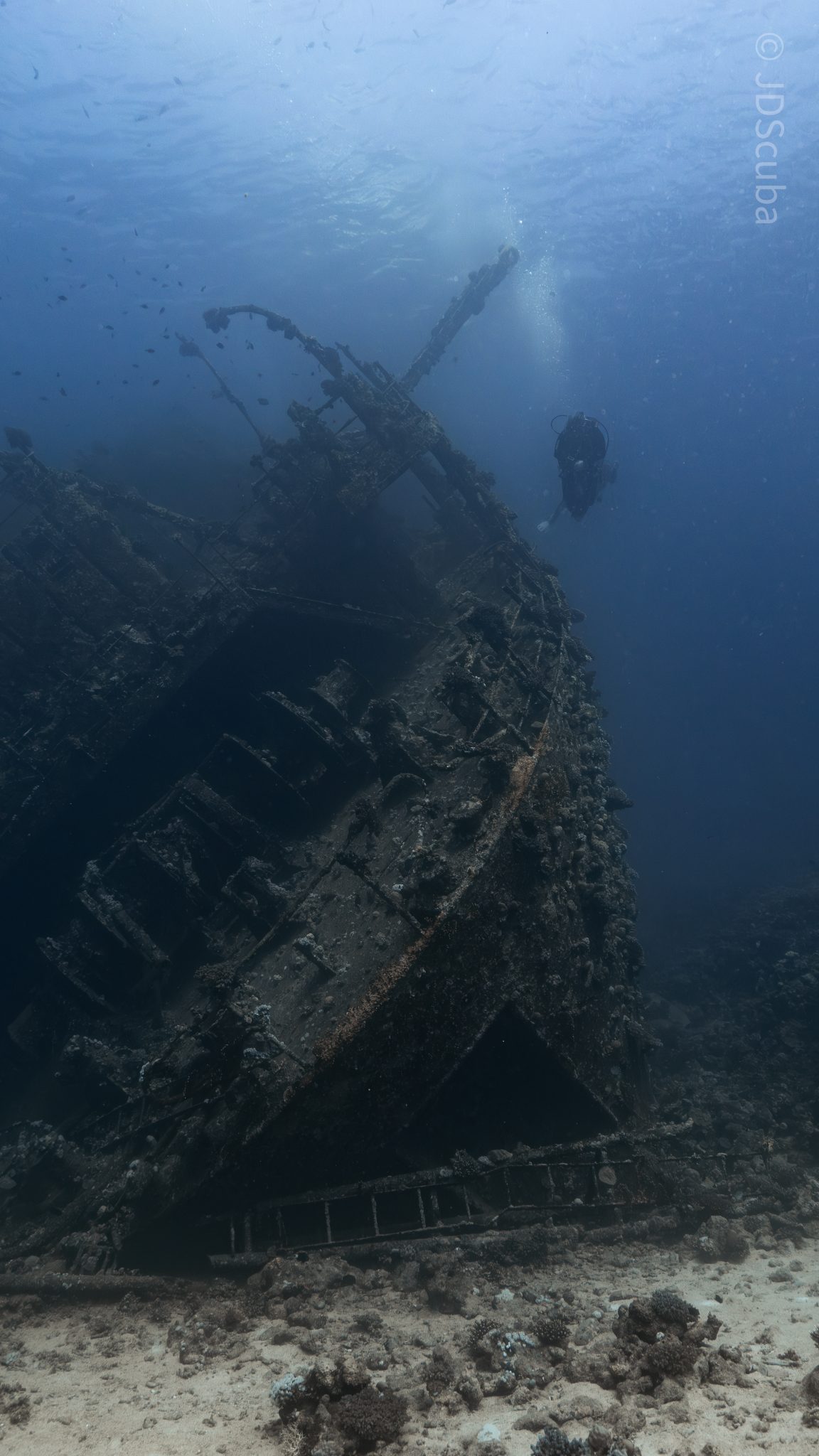
The next morning, it was a short hop to Ras Mohammed Nature Reserve for the next couple of days of diving. The 6am wake-up call came along with the briefing for the first site we would be diving, which was Shark & Yolanda. The low current conditions allowed us to start the dive at Anemone City, where we would drift along the steep, coral-filled wall. These dives involved drifts, as mooring in Ras Mohammed wasn’t allowed to protect the reefs. As a dive site, Shark & Yolanda is well-known and historically had a lot of sharks, but unfortunately not so many in recent years, especially not so early in the season. However, there was always a chance when looking out into the blue.
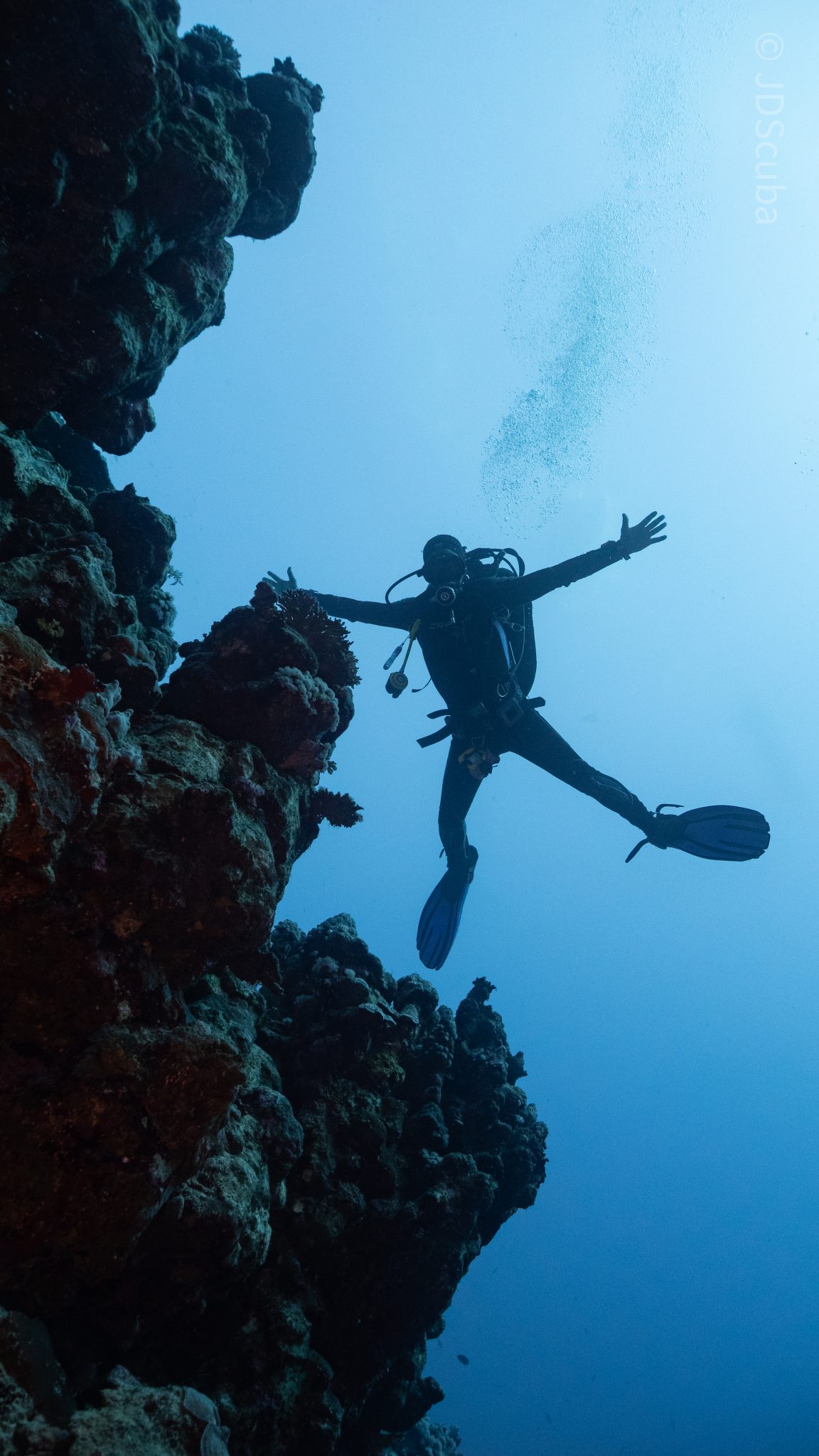
The gentle drift took us along the steep walls of the site, with plenty of anemone fish to be seen and a huge variety of corals. It wasn’t long into the dive before we were accompanied by a hawksbill turtle, who drifted with us between the two atolls before parting ways. Between the two reefs, the shallow patch with parts of coral heads surrounded by sand provided the chance to see a few blue-spotted stingrays that were mainly resting underneath the corals and are always a pleasure to see. With this being the morning dive, the early sunlight lit up the walls, providing tranquil moments. Looking out into the blue, there was very little to be seen, but a small shoal of batfish shimmering underneath the sunlight was a moment to capture as we watched them swim by as they watched us.
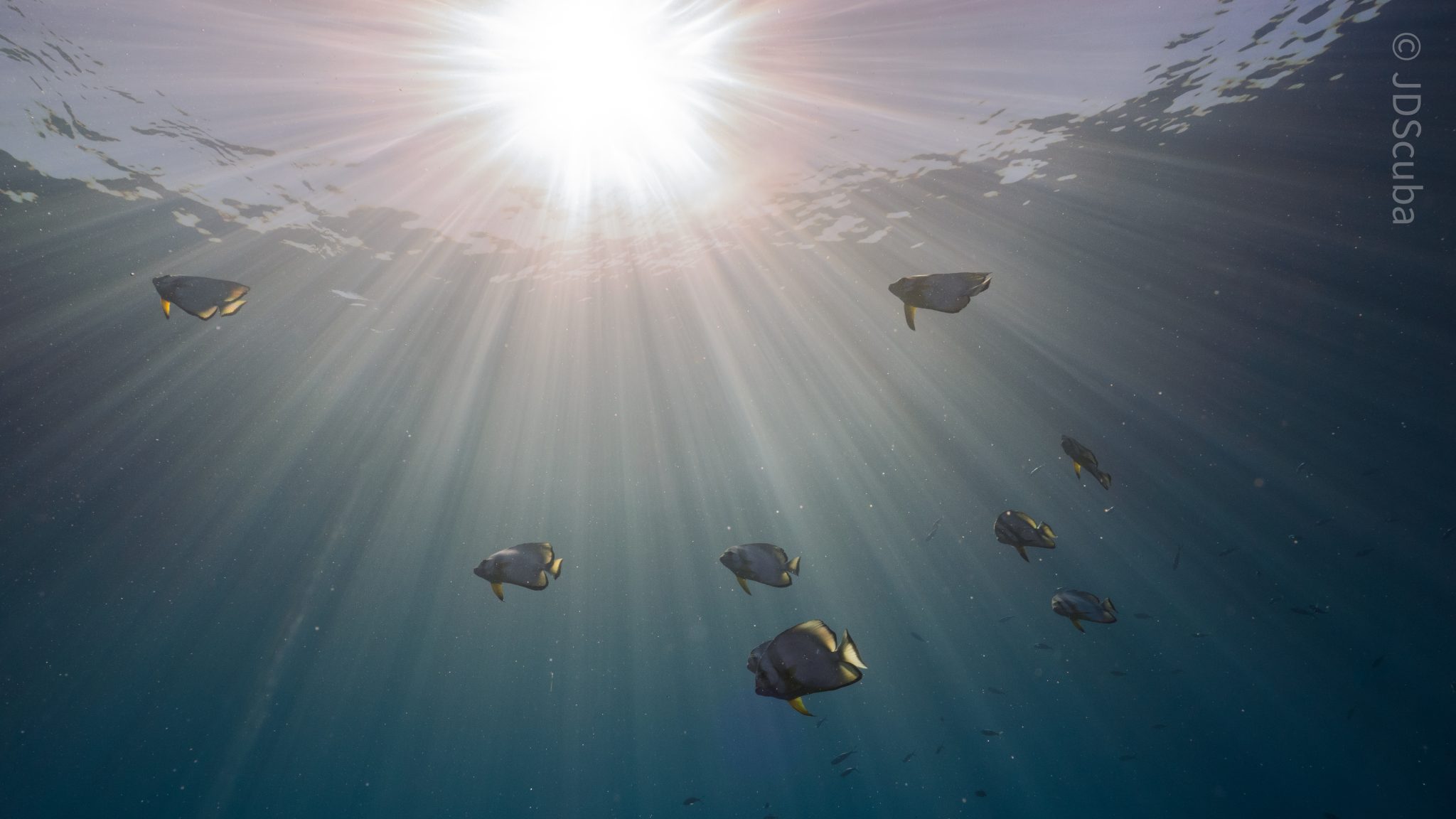
Towards the end of the dive, we stopped at the wreck of the Jolanda where the seafloor was scattered with toilets from the containers it was carrying. This provided a unique site to make a safety stop, which was also accompanied by a large barracuda slowly swimming by, along with a hawksbill turtle calmly swimming over the reef as the sun rays danced in the distance.
For the next dive, we headed north to the Strait of Tiran to explore the reefs situated between Tiran Island and Sharm El Sheik, which were named after the British divers who had found them. We started on Jackson before heading to Gordons Reef, where we also did the night dive. All the atolls at these sites provided stunning, bustling coral reefs close to the surface and steep walls to swim along, which always provided the opportunity to keep an eye out for some of the larger species that can be seen in the blue. Midwater around Jackson Reef was filled with red-toothed triggerfish and shoals of banner fish, which at times were so dense that you couldn’t see into the blue. Moments went by peacefully as we enjoyed the slow drift above the reef, watching these shoals swim around under the mid-afternoon sun.
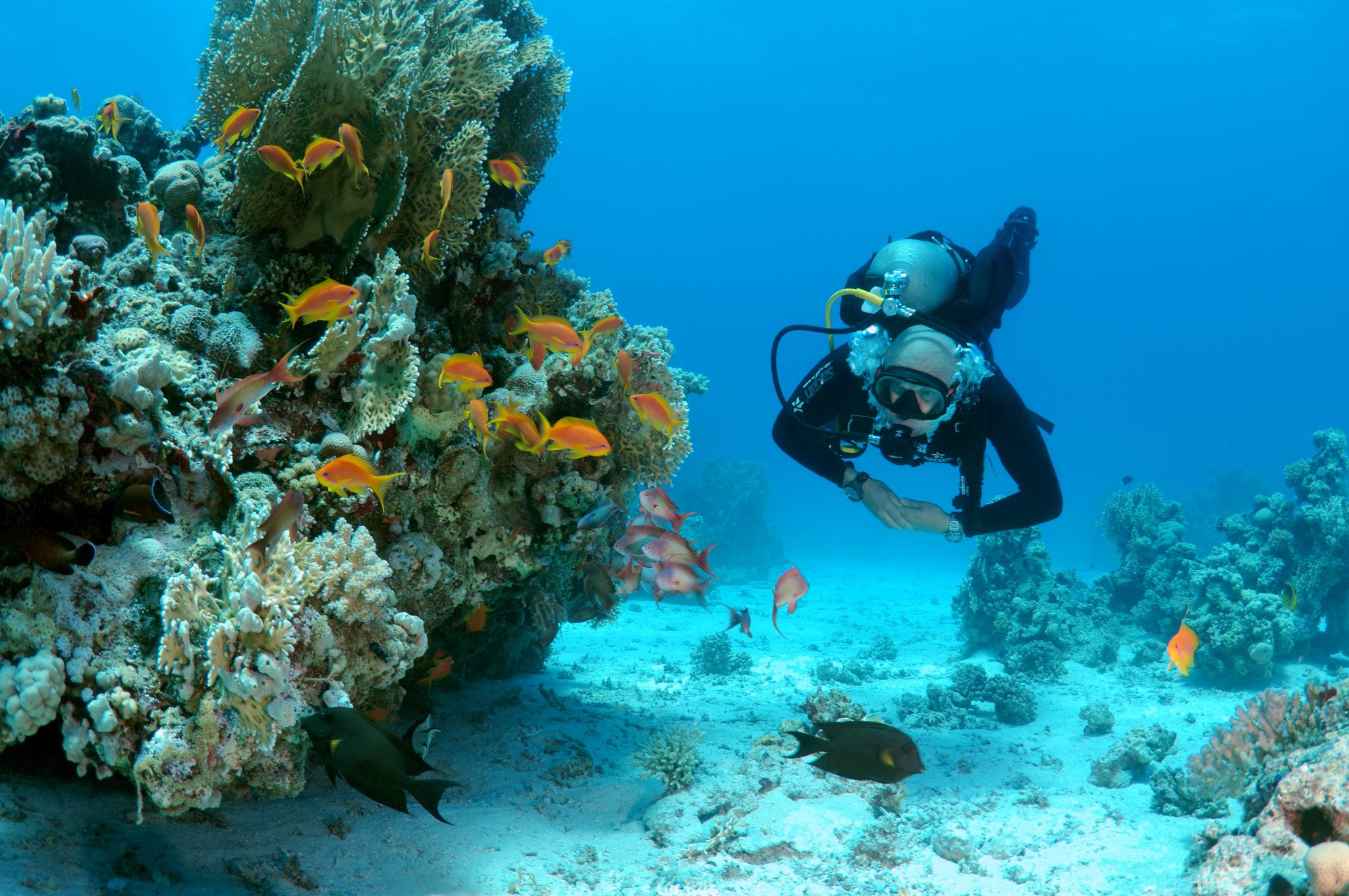
The night dive at Gordon’s Reef was mainly among the stacks of corals surrounded by sand, which was great to explore under the darkness. After some time circling the corals, we came across what we were really hoping to find, and that was an octopus hunting on the reef. We spent the majority of the dive just watching it crawl among the reef, blending into its changing surroundings through changes in colour and skin texture. It’s always so fascinating and captivating to watch these incredibly intelligent animals, in awe of their ability to carry out these physical changes to perfectly blend into the reef. Before we knew it, it was time to head back to the boat to enjoy a well-deserved tasty dinner prepared by the talented chefs onboard.
Check in for the 3rd and final part of this series from Jake tomorrow!
To find out more about the Northern Red Sea reef and wrecks itineraries aboard Ghazala Explorer, or to book, contact Scuba Travel now:
Email: dive@scubatravel.com
Tel: +44 (0)1483 411590
Photos: Jake Davies / Avalon.Red
-
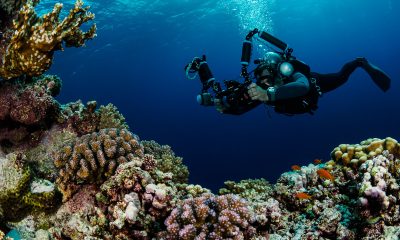
 News3 months ago
News3 months agoHone your underwater photography skills with Alphamarine Photography at Red Sea Diving Safari in March
-
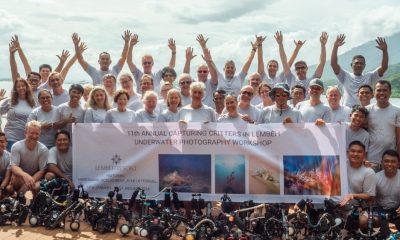
 News3 months ago
News3 months agoCapturing Critters in Lembeh Underwater Photography Workshop 2024: Event Roundup
-
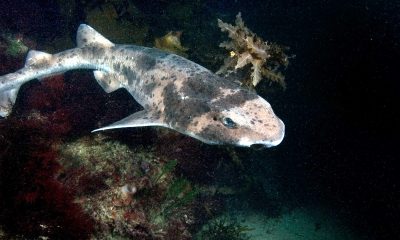
 Marine Life & Conservation Blogs2 months ago
Marine Life & Conservation Blogs2 months agoCreature Feature: Swell Sharks
-
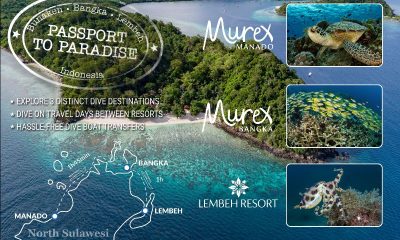
 Blogs2 months ago
Blogs2 months agoMurex Resorts: Passport to Paradise!
-
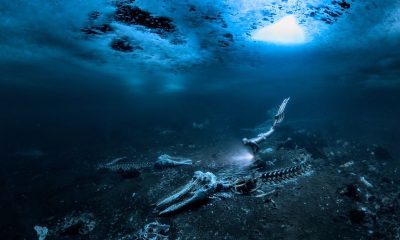
 Blogs2 months ago
Blogs2 months agoDiver Discovering Whale Skeletons Beneath Ice Judged World’s Best Underwater Photograph
-

 Gear Reviews3 months ago
Gear Reviews3 months agoGear Review: Oceanic+ Dive Housing for iPhone
-
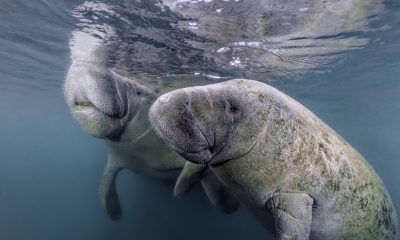
 Marine Life & Conservation2 months ago
Marine Life & Conservation2 months agoSave the Manatee Club launches brand new webcams at Silver Springs State Park, Florida
-
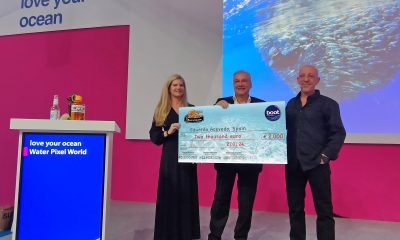
 News3 months ago
News3 months agoWorld’s Best Underwater Photographers Unveil Breathtaking Images at World Shootout 2023



